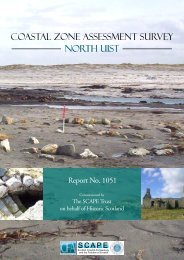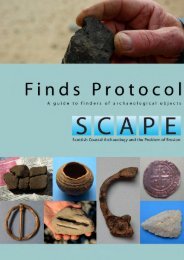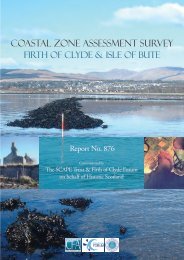COASTAL ZONE ASSESSMENT SURVEY - SCAPE
COASTAL ZONE ASSESSMENT SURVEY - SCAPE
COASTAL ZONE ASSESSMENT SURVEY - SCAPE
You also want an ePaper? Increase the reach of your titles
YUMPU automatically turns print PDFs into web optimized ePapers that Google loves.
3. THE PHYSICAL ENVIRONMENT OF THE STUDY AREAS<br />
3.1 Late Quaternary landforms and environments on Kintyre<br />
3.1.1 In general there is great uniformity in the geological formations along the east<br />
Kintyre coastline, and this has had an important role in shaping the character<br />
of this coastline, which is of notable outstanding scenic beauty. The geology<br />
within the study area is mainly dominated by Precambrian age metamorphose<br />
schists associated with the Dalradian Metamorphic Assemblage (Macgregor<br />
1965). These rocks are mainly metamorphosed marine sediments that produce<br />
a rugged coastline with often steep coastal gradients. At various points along<br />
the coastline, igneous dykes outcrop at the shore. The dykes are<br />
predominantly composed of basaltic olivine-dollerite and are of Tertiary age.<br />
These features are very resilient to coastal erosion and in general they vary in<br />
height from between 0.5-3m and extend well beyond the mean low water<br />
spring tide (MLWST).<br />
3.1.2 At the risk of oversimplification, the internal structural weaknesses within the<br />
schists, typically areas such as joints, fractures and faults, exert a primary<br />
control on both the morphology and rate of cliff erosion in many areas. These<br />
zones of weakness provide areas where accelerated wave erosion has formed<br />
embayments, arches and sea-caves as well as smaller irregularities in the<br />
coastline within the study region (cf Steers 1973). In general terms the rate of<br />
cliff erosion and the resulting landforms are related to both cliff-forming<br />
materials and the physical processes to which they are exposed. Although the<br />
study area lies in a reasonably sheltered sea-loch environment within the<br />
Kilbrannan Sound, storm surges and dominant south westerly wind-driven<br />
wave action continue to shape this area of coastline.<br />
Raised marine shorelines<br />
3.1.3 As with much of the Clyde region, a rock platform occurs above the present<br />
tidal limit along much of the Kintyre coast. The relict shorelines have been<br />
mapped extensively and are depicted on the modern solid and drift edition<br />
1:50 000 produced by the British Geological Survey (BGS). The older 1 inch<br />
seventh series maps also produced by BGS depict the three main raised<br />
shorelines, namely the low, medium and high raised beach. Isostatic recovery<br />
has altered the altitude at which these features now rest. Between Skipness<br />
and Claonaig, a former intertidal platform up to 150m wide is visible and is<br />
largely covered by Juncus wetland (Firth and Collins 2002). Typically these<br />
platforms are backed by relict cliff lines (e.g. Smerby Rocks NR 760 232). In<br />
other areas, the intertidal platform is less well defined (e.g. Port Righ NR 8170<br />
3795) but is better preserved at the sheltered heads of small embayments.<br />
Other platforms possibly attributable to the Loch Lomond Re-advance and<br />
more recent Holocene age storm levels are more common above the mean high<br />
water spring tide (MHWST) and the backshore area. These are often more<br />
pronounced in areas where softer marine sediments have been redeposited or<br />
where areas of Devensian age till have been remodelled as a result of higher<br />
sea levels during the Maximum Marine Transgression.<br />
KACL/997/0<br />
11<br />
CFA









